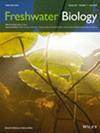地球上最大的高原上内河的生物多样性和群落组合
IF 2.7
2区 生物学
Q2 ECOLOGY
引用次数: 0
摘要
本文通过对青藏高原上两条内源性河流(察楚藏布江和布楚藏布江)冰缘至湖泊水样的环境DNA元基因组和元编码测序数据进行分析,研究了不同分类类群(细菌、真菌、真核藻类、原生动物、后生无脊椎动物和脊椎动物)的α和β多样性以及驱动群落聚集的生态过程。除扎丘藏布江的真菌外,大部分分类类群的α多样性从冰缘到湖泊没有明显的连续变化。α多样性与细菌的总氮和铵态氮、真菌的浊度、真核藻类的总磷和硝态氮、原生动物的氯离子和后生动物无脊椎动物的总磷等环境因子呈显著相关。这些类群的群落组成与水温、浊度、硝态氮和总有机碳等相似的环境因子呈显著相关。同质选择、扩散限制和漂移对两河群落的聚集起主要作用,与后生无脊椎动物和真菌相比,细菌、真核藻类和原生动物的确定性过程更重要,而随机过程的重要性更低。结果表明,不同的环境因子与两内河多分类类群的α和β多样性相关。确定性过程在细菌、真核藻类和原生动物的群落组装中比在后生动物无脊椎动物和真菌中更为突出。这些发现将有助于了解QTP上的水生生物如何应对气候变化。本文章由计算机程序翻译,如有差异,请以英文原文为准。
Biodiversity and Community Assembly of Endorheic Rivers on Earth's Largest Plateau
- Understanding biodiversity distribution patterns and related environmental factors and community assembly mechanisms is crucial for deciphering community responses and feedback to global changes, but it remains largely unknown in aquatic ecosystems on the Qinghai-Tibet Plateau (QTP) which is the Asian water tower and one of the regions most severely affected by climate changes.
- Here, by analysing environmental DNA metagenomic and metabarcoding sequencing data of water samples from the ice margin to the lake along two endorheic rivers (Tsachu Tsangpo and Bochu Tsangpo) on the QTP, we examined the alpha and beta diversity and the ecological processes driving community assembly of various taxonomic groups (bacteria, fungi, eukaryotic algae, protozoa, metazoan invertebrates and vertebrates).
- We found no significant continuous change in alpha diversity from the ice margin to lake along the two rivers for most taxonomic groups, except for fungi in Tsachu Tsangpo, which showed a gradual decline. Alpha diversity was significantly correlated with various environmental factor, including total nitrogen and ammonium nitrogen for bacteria, turbidity for fungi, total phosphorus and nitrate nitrogen for eukaryotic algae, chloride ion for protozoa and total phosphorus for metazoan invertebrates. Community compositions of these taxonomic groups were significantly correlated to similar environmental factors, such as water temperature, turbidity, nitrate nitrogen, and total organic carbon.
- Furthermore, homogeneous selection, dispersal limitation and drift mainly contributed to the community assembly in both rivers, with a higher importance of deterministic processes and lower importance of stochastic processes for bacteria, eukaryotic algae and protozoa than for metazoan invertebrates and fungi.
- The results demonstrated various environmental factors correlated with the alpha and beta diversity of multi-taxonomic groups in the two endorheic rivers. Deterministic processes were more prominent in the community assembly of bacteria, eukaryotic algae and protozoa than in metazoan invertebrates and fungi. These findings would help to understand how aquatic organisms on the QTP respond to climate change.
求助全文
通过发布文献求助,成功后即可免费获取论文全文。
去求助
来源期刊

Freshwater Biology
生物-海洋与淡水生物学
CiteScore
5.90
自引率
3.70%
发文量
162
审稿时长
2 months
期刊介绍:
Freshwater Biology publishes papers on all aspects of the ecology of inland waters, including rivers and lakes, ground waters, flood plains and other freshwater wetlands. We include studies of micro-organisms, algae, macrophytes, invertebrates, fish and other vertebrates, as well as those concerning whole systems and related physical and chemical aspects of the environment, provided that they have clear biological relevance.
Studies may focus at any level in the ecological hierarchy from physiological ecology and animal behaviour, through population dynamics and evolutionary genetics, to community interactions, biogeography and ecosystem functioning. They may also be at any scale: from microhabitat to landscape, and continental to global. Preference is given to research, whether meta-analytical, experimental, theoretical or descriptive, highlighting causal (ecological) mechanisms from which clearly stated hypotheses are derived. Manuscripts with an experimental or conceptual flavour are particularly welcome, as are those or which integrate laboratory and field work, and studies from less well researched areas of the world. Priority is given to submissions that are likely to interest a wide range of readers.
We encourage submission of papers well grounded in ecological theory that deal with issues related to the conservation and management of inland waters. Papers interpreting fundamental research in a way that makes clear its applied, strategic or socio-economic relevance are also welcome.
Review articles (FRESHWATER BIOLOGY REVIEWS) and discussion papers (OPINION) are also invited: these enable authors to publish high-quality material outside the constraints of standard research papers.
 求助内容:
求助内容: 应助结果提醒方式:
应助结果提醒方式:


